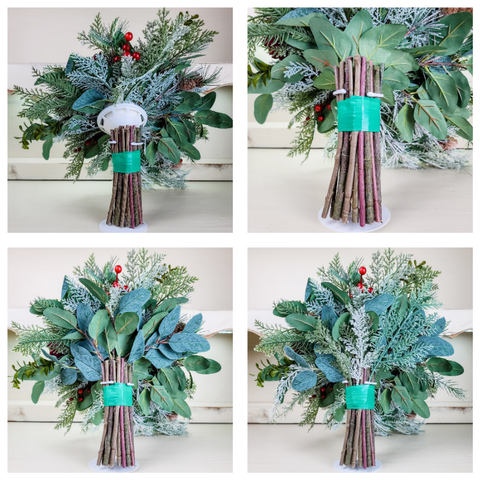Bouquet Handles!
You’ve dyed your flowers, stemmed them, chosen your filler and created the perfect bouquet! Now comes the big question - how do you want to finish the handle?!
Here are a few tried and true ways to wrap your handles!
Burlap/Ribbon Full Handle Wrap
A full handle wrap is one of the most traditional styles of finishing off your bouquet. With this technique, you can use ribbon, burlap, lace...so many different options are available!

To start, I cut the wires to the length I wanted them (general rule - place your two fists, one above the other, under the bouquet on the handle and add 1-2” of open wire at the bottom for the length) and then covered the entire handle in green vinyl tape. You can also use floral or electrical tape to cover the handle.
Next, I cut two 2-3” strips of my jute burlap ribbon (really great ribbon if you are looking for a twine vibe!) and hot glued each to the bottom of the wrapped handle as you can see in the top right and bottom left pictures.
Once your handle bottom is covered, it is time to get the handle fully covered! Add a little hot glue to the top of the tape and place the end of your ribbon on it to set it in place.
Time to start wrapping! Pulling the ribbon tight, start twisting your bouquet and covering the handle. This first pass on the way down will have bumps and not look super smooth. No need to worry about that! This is why we come back up and rewrap the handle, paying attention to the space between the edges of the ribbon you can see.
Once you have wrapped back up to the top, fold your ribbon at an angle (see the bottom right picture) and glue that down!

While the glue is drying, cut the ribbon along the final edge. At this time, you can add a little hot glue to ensure anything that may be loose is secured down.
And there you have it! A tight, fully covered handle.
Corn Broom Handle
The easiest way to cover your stems with a beautiful look is to use corn broom to finish it off. Take a look at the YouTube tutorial below to see how best to add it to your bouquet!
If you want to glam up your twine wrap a little, here are two simple ways to do that!

After wrapping with twine, cut a separate piece of twine and tie it around the handle. Adding a small bow gives the bouquet an adorable finish.

To make the twine handle look even fancier, cut three equally long pieces of twine. Tie a knot on one end and begin braiding the twine together (you will want thin twine for this and can also use string, yarn, etc). Once you have completed the braid, cut the top knot off and glue the braid to the top of your twine handle. Wrap the braid completely along the top part. Add just a dab of glue where the top braid piece connects to itself. When the glue is dry, pull the braid down across the front of the bouquet and glue the braid to the bottom of the twine wrap. Wrap that braid around the bottom of the wrap fully until you are able to create an "X" pattern by pulling the braid back up to the top of the twine wrap. Add another dab of hot glue to the final connection point and cut off any excess braid.
It sounds complicated but if you play around with braided twine, you can create some amazing designs on your handle!
Faux Filler Stems/Chiffon Ribbon Partial Wrap
Time to finish off this spring bouquet we have done a few blogs on already (how to dye the flowers and how to make the bouquet)! For this one, I wanted to show how to use faux filler to finish it off with a long flowing, muslin/chiffon ribbon.

First step, make sure your stems are cut down to slightly shorter than the length you want the handle to be. For this style of handle finish, you do not want the vinyl or floral tape to cover the entire length of the stems.

Ok so faux filler stems. The first thing you want to do is pull the ones that will work with your design. Then you want to cut them to a length that allows for approximately 1” to tuck up inside the greenery/filler/flowers (top right picture shows you how to blend it at the top of the handle) and a half inch to go below the cut wires that will be in the center of the handle.
Add the stems to your handle in thirds. After you add a section of stems, tape it down. Do this the full way around. You may notice that your stems take on a sort of spiral look (bottom left picture). To help fix this, gently pull/bend out the bottoms of the faux stems and readjust them so it looks like a more realistic, natural base.

For this wrap, I went with a muslin/chiffon ribbon as I wanted a long flowing addition to this bouquet. To start, find the center of your ribbon and tie it around the top of the section you want to have covered (left photo). For this purposefully unfinished ribbon look, continue tying the ribbon in different sections on the way down to cover the tape and however much of the handle you want covered. I added a simple bow (trust me, this is the best I can do!), to finish off this sweet bouquet.

The Cascade
This one can be a doozy and if you are working with a tilted bouquet handle, this is probably something you have been waiting to see!


First step is to wrap the holder in jute twine (I use an extra thick version to really bulk this part up!). When working with cascades, always glue your starting piece of the twine/ribbon/etc. to the underside first. It won’t be seen so that is where I both start and end everything!
Like any other type of wrap, I start at the top, wrap down to the bottom and back up to the top again.
If you didn’t want to add faux stems, you could easily skip the next step to move onto covering the plastic circle section and either keep the twine as your finished wrap or add ribbon over top of that!

If you want to have a natural stem look, now is the time to add your faux filler stems. They do not need to match exactly so long as they work well together! Add them in sections as stated earlier in this blog (in the chiffon wrap section) and tape down as you add. Since the holder is tilted, you will need the stems underneath towards the front of the bouquet to be shorter than those in the back.
Once the faux stems are on, glue leaves directly to the plastic circular section. These don’t have to look all that pretty. The purpose of them is to make sure the white plastic cannot be seen after you add your final filler pieces.
Since we want to make sure the stems are actually connected to the cascade, it is important to add greenery and fillers to finish this part out. I snuggled in some extra eucalyptus to come from the top of the faux stems to start. To tie the rest of the fillers used in the cascade, I then added a few pieces of filler over top of the stems and taped them down.

Now that the stem tops are hidden into the overall cascade, you can finish off the handle in whatever way you want! I decided to to a ¾ wrap in satin ribbon.
Once again, I started by gluing down the start of the ribbon on the underside of the cascade handle. When that is set in place, pull tightly and twist your bouquet until you have covered as much of the handle as you would like. With satin ribbon especially, I will glue the bottom ribbon wrap down (middle picture) and let that dry before starting back up to finish it off.
At the top of this handle design, I did a little ribbon twist trick to make a fun little top finish. Just twist your ribbon every inch or so around the full bouquet. The right photo shows two rows of this!

You can incorporate any of these techniques into any type of bouquet. Let us know if there is any other handle wrap you would love to see!
**If the listing is for an amazon link this is an affiliate link. It costs you nothing but OYL will get a small percentage from the sale if you decide to purchase. Thank you!
Collection
Contact us
© 2026 Oh! You're Lovely - Sola Wood Flowers, All rights reserved. |



